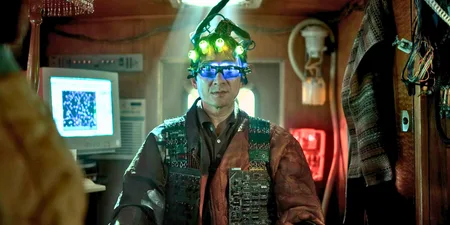Allow me to geek out for a minute….*ahem*
With the influx of the yearly release of Call of Duty games, the first person shooter genre has quickly become as refreshing and palatable as a pint of sand, each iteration simply adding a new, albeit thin, coat of paint onto an old formula. Pick up this gun, take cover, shoot this guy, take cover, let health regenerate, shoot that guy, take cover, let health regenerate. (Unpopular opinion warning:) It’s been the gaming equivalent of the Fast and Furious films. Minor tweaks and changes, bigger action, but no genuine difference, no substance, and no heart – all this coming from someone whose number one genre is first person shooters; was born and raised on the original Doom game, Wolfenstein 3D, Quake and latterly Half-Life.
Let’s go back in time for some perspective. Back in the day first person shooters were the seminal genre for technology, and therefore impressing your mates. So many game engines in use now stemmed from their pioneering work in first person shooters, and this still extends to today. Case in point? Goat Simulator uses the Unreal 4 game engine.
Id Software’s Wolfenstein 3D was the first shoot-em up as we know them today (discounting the likes of ‘Maze War’….look it up kids.): a seemingly 3D world whereby you see through the eyes of the hero “BJ Blazkowicz” shooting Nazi’s in the face as you escape imprisonment. Next was “the grandaddy of first person shooters” and the one that launched the genre into the mainstream, famously used by the US Military as a simulator, Doom was “seemingly 3D”, like Wolfenstein, only this time enemies would attack from above you and below; lifts and stairs were introduced and ledges could be “jumped over” (hold down sprint to clear the gap.)
Duke Nukem 3D arrived on our hard-drives in January 1996, not only introducing the ability to look up and down (mad, right?) but also satirising pop-culture and spoofing macho over the top Hollywood action heroes within the game, coupled with a risqué sense of humour, this set it apart. Although garnering critical acclaim purely from a gaming standpoint, it did attract criticism for the myriad of sexist imagery.
Id Software returned with Quake that summer with a fully 3D game engine; a first for the genre, and this was followed by Quake 2 in late 1997, and shortly after, a genuine classic of any genre in November 1998: Half-Life. A game that introduced puzzle elements, massively varying enemy types with massively varying A.I, and never broke up the storyline with cutscenes, keeping you in-game, in the shoes of its protagonist Gordan Freeman from the first minute, until the last. Rainbow Six, was also released in 1998, and took the genre to the most tactical of places. One shot kills, a snails pace, planning your tactics and your assault, and a reliance on your AI team mates were all part and parcel of a shooter that couldn’t be further away from Doom.
All of these mentioned were on PC’s, before being ported to consoles. But then there was GoldenEye 007. Sweet, sweet GoldenEye. Released as a Nintendo 64 exclusive in August 1997, this set the standard for console first person shooters and massively influenced the likes of Call of Duty and Halo. This is the only time I regretted not buying an N64.
The still predominantly based PC genre spread its wings into multiplayer with the likes of Quake 3, Unreal Tournament and Counter Strike before the Xbox landed in 2001 with its magnum opus: ‘Halo’. A game that screamed its console abilities from every rooftop possible. Refining and tweaking what is expected when it came to a console centric first-person shooter: Only two weapons could be held at once, the health system was a recharging shield (with health in the first iteration, this would change to purely recharging health), two console shooter staples that have been emulated time and time again.
Console exclusive shoot-em ups were not completely new (look at Medal of Honour on the Playstation, as well as 007), however, they had announced themselves, and were here to stay. And due to the accessibility of consoles and their units of sales of consoles being far greater than that of PC’s, the pendulum would start to swing towards consoles as their popularity skyrocketed, after all – Halo was originally touted as a PC game before being made specifically, and exclusively, for Microsofts debut console.
Finally, the glass ceiling had been broken. When a game as groundbreaking as Halo arrives and shows everyone that consoles can muscle in on what was an extremely popular, but PC centric genre, there are going to be imitators and copy-cats to take advantage in, initially incredible, but soon-to-be formulaic ways.
Which brings us to 2003 and ‘Call of Duty’. We all knew I was going to touch on this institution very soon. Now don’t get me wrong, I’ve loved the Call of Duty games for years, I brought the very first one on the PC and remembered spending more time watching the kill cams in multiplayer than doing any actual gaming myself. Because I was shit at it. However, taking charge of an American paratrooper, then a stiff upper lipped Brit (holding Pegasus Bridge might be one of the most heroic things i’ve ever accomplished in my life), followed by a playing as a Russian armed with only five bullets in Stalingrad, a sequence lifted straight out “Enemy at the Gates” was epic.
Skip forward a few years to 2007. One of the best years for the FPS genre in memory. The makers of the original Far Cry (itself brilliant and groundbreaking) released Crysis on the PC and was a genuine leap in technology, being so utterly brilliant and looking so gorgeous it put a lot of people off who couldn’t afford to upgrade their PC to be able to run it properly. This made it too powerful for the consoles of the time to handle, as proven by the far more linear and streamlined sequels which were released on consoles as well.
Then there was possibly the greatest gaming collection of all time: ‘The Orange Box’. The collection boasted Half-Life 2, which is one of the best shooters of all time, plus its add ons Episode 1 and 2. Added to this was Team Fortress 2, a cartoony team based multiplayer only game (now available for free!) and the ingenious pacifist first person puzzle solver ‘Portal’ and you have one hell of a collection. And let’s not forget game with one of the best twist endings ever; Bioshock.
The 5th of November 2007 was the moment that Call of Duty changed from a game into the institution that it is today with the release of Call of Duty 4: Modern Warfare. The single player is brilliant – but it was with the multiplayer that gripped players and refused to let go, with your constant character evolving, upgrading and unlocking new perks, weapons and accessories, load outs and support through the kill-streak system that we’re all very aware of by now.
And that was it. For years the Call of Duty games, by now well into their stride, were the cream of the charts every year in sales and other developers couldn’t help but follow suit (just look at every multiplayer mode in every shooter at the moment, from Halo to Overwatch). This of course meant a sudden lack of originality in comparison to the 90’s and early 2000’s of the Quakes, Half-Lifes’ and Duke Nukems of this world.
While there were a couple of shining lights in the years of playable but extremely unoriginal shooters, they had to delve into other genres to garner attention and acclaim: Dishonoured….Fallout….Portal 2 (the furthest thing from a first person shooter possible, whilst still being played in first person, with a shooting mechanic) erm….yeah that’s about it really! Which goes to show how important one particular release in 2016 was.
Id Software and Bethesda’s “Doom”, released in May 2016 brought the genre full circle. Stripping the first-person shooter down to its barebones, standard functions such as sprint, aiming down the sites and reloading were all gone, and taking the shooter back to the balls out blowing to pieces of anything and everything that moves. It rewards players with health and ammo by getting stuck in, instead of taking cover, aiming down the sites, shoot, rinse, repeat – the dynamics of the shooter completely changed. If you haven’t played it you simply must. Bethesda built on this in Wolfenstein 2: The New Colossus, as well as breaking into Virtual Reality with the release of “Doom: VFR.” Doom. In. Virtual. Fucking. Reality. And it’s glorious. “Call of Duty: WW2” has taken things back to its roots with the setting, whilst also borrowing the risk/reward element from Doom in that the more kills you rack up, the quicker your team mates can resupply you and is very, very good too.
We have a host of original titles to look forward to as well next year – War of Rights is set during the American Civil War, a long overdue reboot of System Shock, Str Citizen, which is a mix of a space sim, open world action game and first-person shooter and “Escape from Tarkov”, as well as a host of sequels such as Far Cry 5 and Serious Sam 4.
The First-Person Shooter is dead, long live the first person shooter.











































